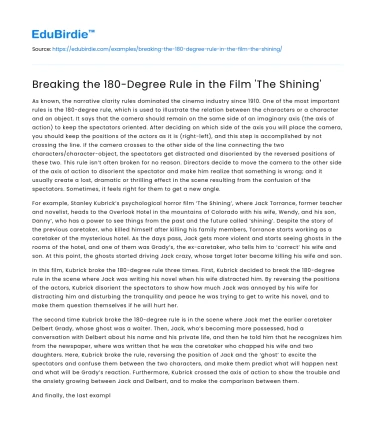As known, the narrative clarity rules dominated the cinema industry since 1910. One of the most important rules is the 180-degree rule, which is used to illustrate the relation between the characters or a character and an object. It says that the camera should remain on the same side of an imaginary axis (the axis of action) to keep the spectators oriented. After deciding on which side of the axis you will place the camera, you should keep the positions of the actors as it is (right-left), and this step is accomplished by not crossing the line. If the camera crosses to the other side of the line connecting the two characters/character-object, the spectators get distracted and disoriented by the reversed positions of these two. This rule isn’t often broken for no reason. Directors decide to move the camera to the other side of the axis of action to disorient the spectator and make him realize that something is wrong; and it usually create a lost, dramatic or thrilling effect in the scene resulting from the confusion of the spectators. Sometimes, it feels right for them to get a new angle.
For example, Stanley Kubrick’s psychological horror film ‘The Shining’, where Jack Torrance, former teacher and novelist, heads to the Overlook Hotel in the mountains of Colorado with his wife, Wendy, and his son, Danny’, who has a power to see things from the past and the future called ‘shining’. Despite the story of the previous caretaker, who killed himself after killing his family members, Torrance starts working as a caretaker of the mysterious hotel. As the days pass, Jack gets more violent and starts seeing ghosts in the rooms of the hotel, and one of them was Grady’s, the ex-caretaker, who tells him to ‘correct’ his wife and son. At this point, the ghosts started driving Jack crazy, whose target later became killing his wife and son.
Save your time!
We can take care of your essay
- Proper editing and formatting
- Free revision, title page, and bibliography
- Flexible prices and money-back guarantee
In this film, Kubrick broke the 180-degree rule three times. First, Kubrick decided to break the 180-degree rule in the scene where Jack was writing his novel when his wife distracted him. By reversing the positions of the actors, Kubrick disorient the spectators to show how much Jack was annoyed by his wife for distracting him and disturbing the tranquility and peace he was trying to get to write his novel, and to make them question themselves if he will hurt her.
The second time Kubrick broke the 180-degree rule is in the scene where Jack met the earlier caretaker Delbert Grady, whose ghost was a waiter. Then, Jack, who’s becoming more possessed, had a conversation with Delbert about his name and his private life, and then he told him that he recognizes him from the newspaper, where was written that he was the caretaker who chapped his wife and two daughters. Here, Kubrick broke the rule, reversing the position of Jack and the ‘ghost’ to excite the spectators and confuse them between the two characters, and make them predict what will happen next and what will be Grady’s reaction. Furthermore, Kubrick crossed the axis of action to show the trouble and the anxiety growing between Jack and Delbert, and to make the comparison between them.
And finally, the last example of how Kubrick broke the 180-degree rule is the scene in which Jack tried to kill his son. Here, the line is drawn between Jack Torrance with his ax and the door. The director made a close-up shot of Jack in this scene then he crossed to the other side of the line to disorient, confuse, and to scare the spectators of what will happen next, if he will reach Wendy and his son and kill them or not.
To conclude, the 180-degree rule is often broken on purpose and its target is to create a lost and dramatic mood. Moreover, crossing the line disorient and distract the spectators; so, it’s important in horror movies to break the rule and move the camera to the other side of the axis of action, especially when we need to make the comparison between two characters, just as Kubrick did in his film ‘The Shining’.






 Stuck on your essay?
Stuck on your essay?

